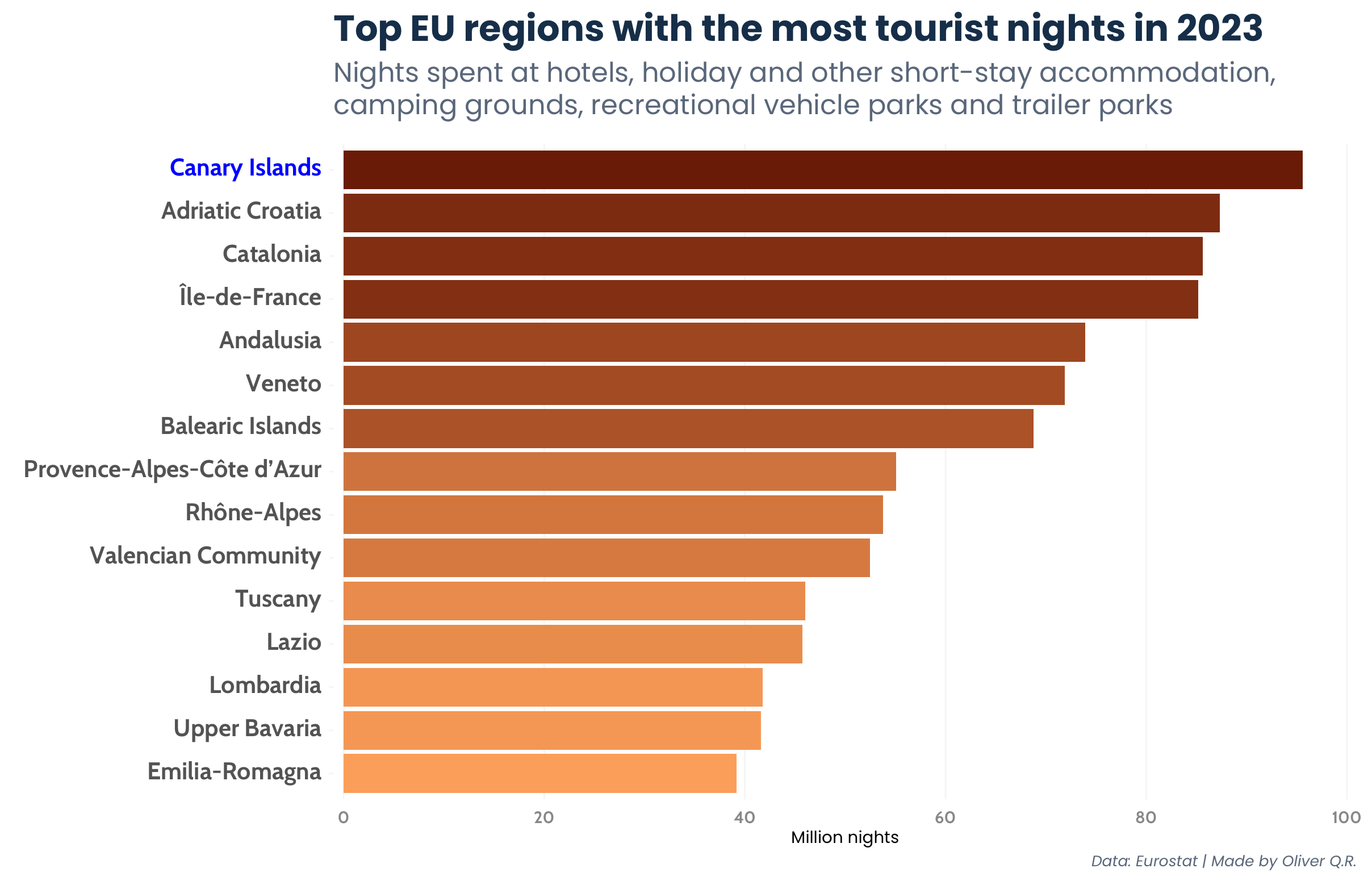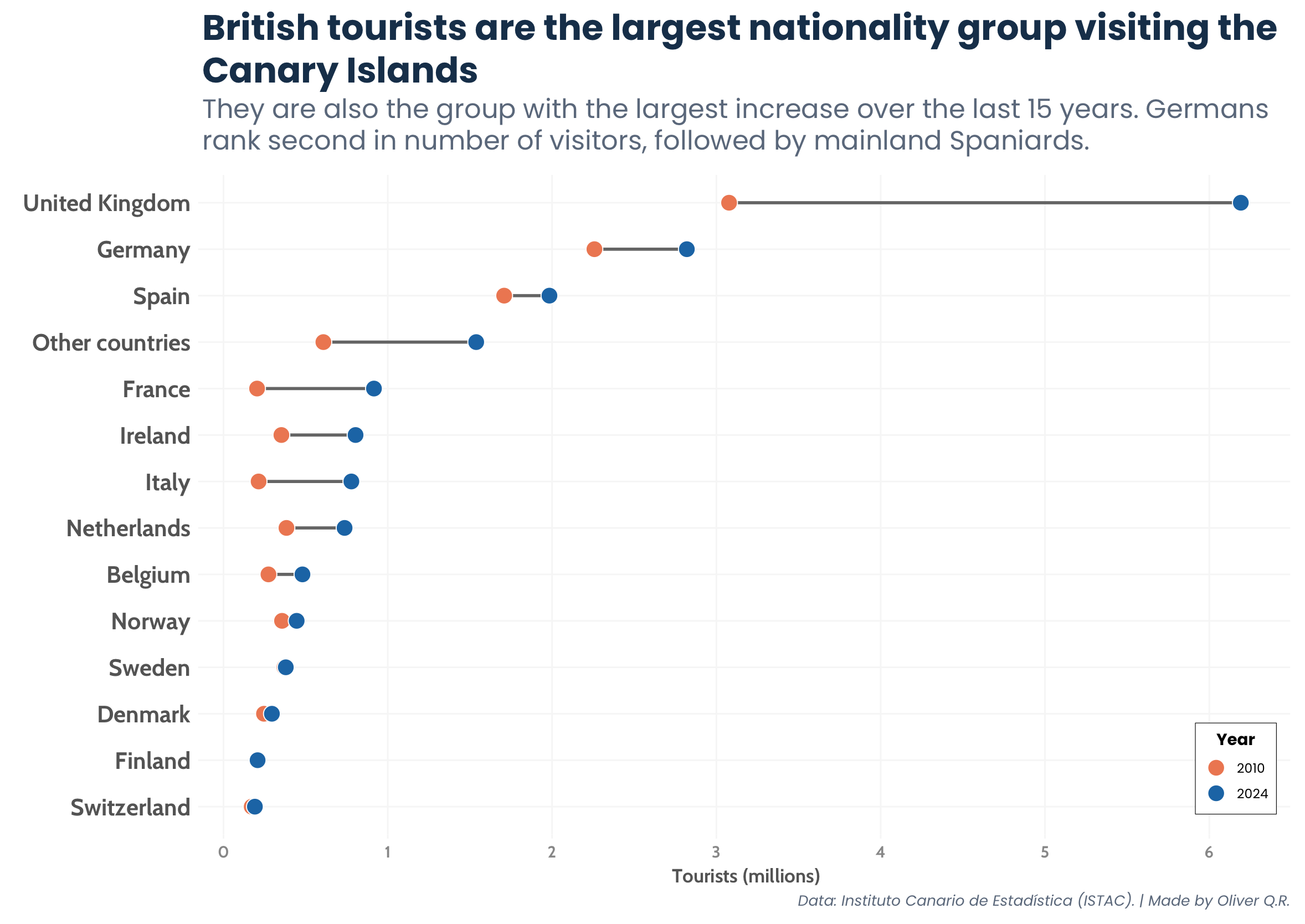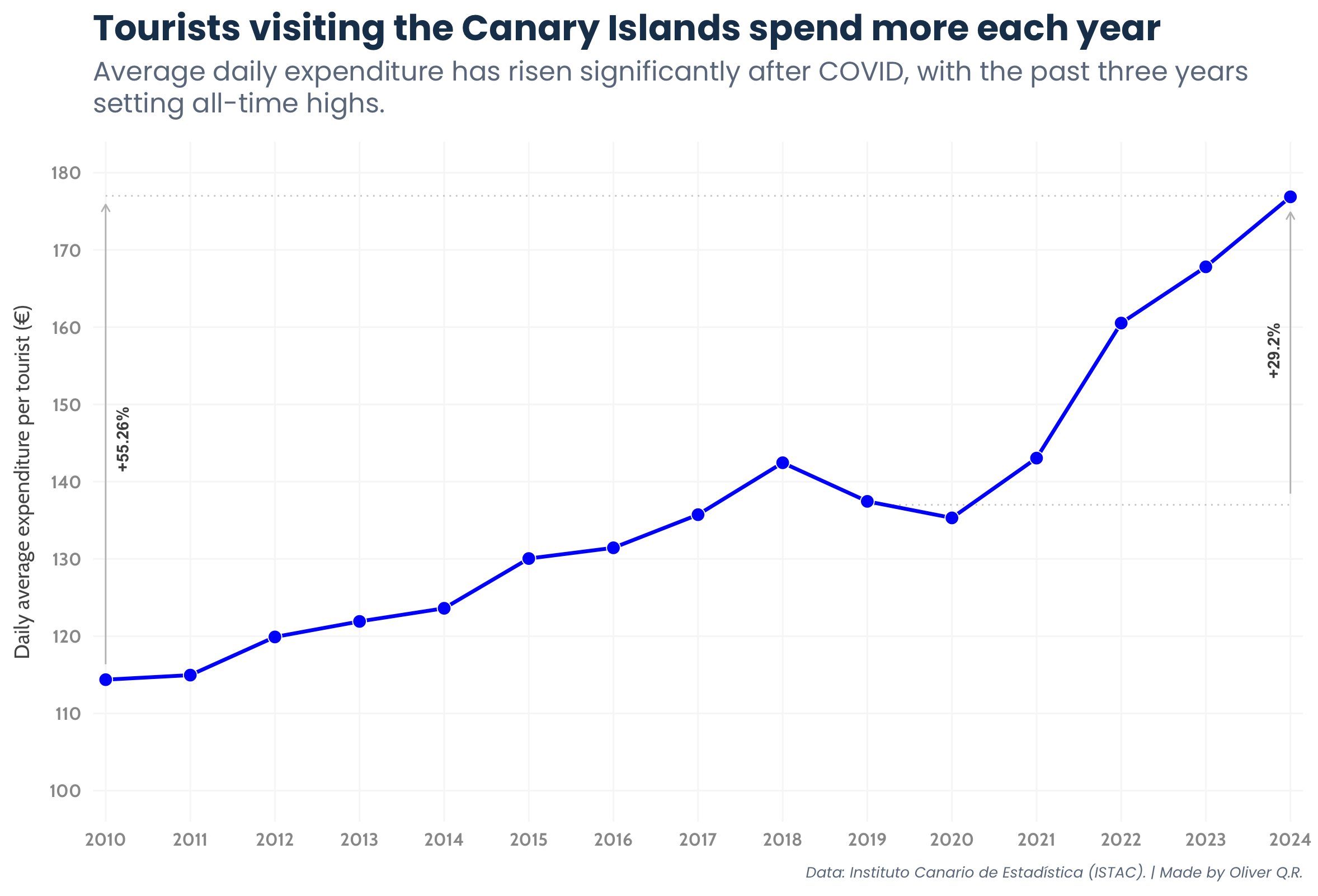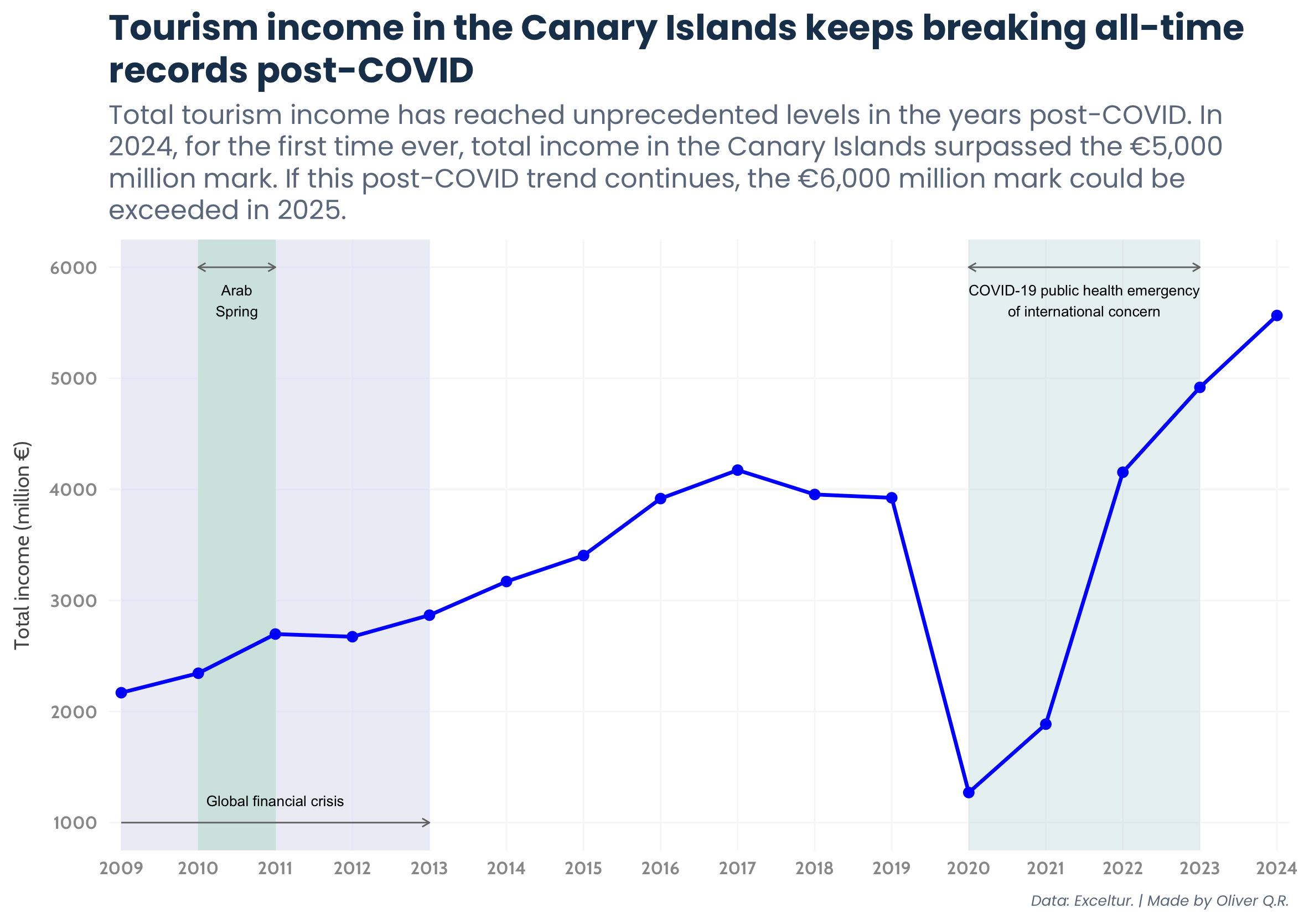Tourism in the Canary Islands - Part I: A booming industry.
Posted onLocated at the crossover of three continents, the Canary Islands are well known as one of the main tourists destinations for Europeans. Often referred to as The Fortunate Islands in ancient times, the islands enjoy a mild climate that allows for outdoor activities all year round. Locals and visitors can explore the many natural attractions in the islands, including diverse and stunning landscapes, four national parks, volcanoes, rainforests, long sandy beaches, a rich and extraordinary gastronomy, etc., all wrapped in an easy-going way of living that make the Canary Islands a dream destination for many.
In fact, with over 95 millions in 2023, the Canary Islands were the EU region with the highest number of nights spent in tourist accommodations (figure 1), surpassing popular tourist destinations such as Adriatic Croatia, Île-de-France (where Paris is), Catalonia (Barcelona), Veneto (Venice), Balearic Islands, Tuscany (Florence) or Lazio (Rome).

Although the origins of the tourist industry in the Canary Islands can be traced back to the second half of the XIX century, its large-scale development didn't take off until the 1960s and 1970s, gradually becoming the islands' main industry.
In this post, I will go through some of the key tourism indicators in the Canary Islands and how they have evolved over recent years. This will give us a snapshot of the current state of this industry in the archipelago, and will set the stage to explore its socioeconomic impact in the islands (in a future post).
So, let's dive right in!
Yearly tourist arrivals to the Canary Islands

In 2005, 11.3 million tourists arrived in the Canary Islands. By 2024, this number had increased to 17.8 millions (+57.5%). Between 2005 and 2013 growth was relatively modest (+7.7%), likely due to the global financial crisis. After that, tourist arrivals soared in the period 2013-17, rising by 31.1% in just four years.
After a slight drop in 2018-19, the industry was hit hard by the COVID-19 pandemic, which led to a sharp decline in arrivals due to global travel restrictions. However, there was a major rebound already by 2022, with visitor number nearly reaching the pre-pandemic levels. This upward trend continued in 2023 and 2024, with both years setting new records.
Which is the most popular island?

The most visited island in 2024 was Tenerife, with over 7.2 million visitors (40.3% of all tourists that visited the Canary Islands; figure 3 & table 1). Gran Canaria was the second most popular island, with 4.6 million tourists (25.54%), followed by Lanzarote (3.2 million; 18.03%) and Fuerteventura (2.5 million; 13.88%). At the other end, La Palma, with 170,147 tourist arrivals (0.95%), La Gomera and El Hierro (232,661 combined; 1.3%) were the islands with the fewest tourists.

Yearly tourist arrivals by island
Tenerife is also the island with the largest increase in tourist arrivals over the past 15 years, with an impressive 84.2% rise since 2010 (figure 4). It is also the island with the steepest annual increase in arrivals post-COVID.
Lanzarote experienced a 71.4% increase in visitors in 2024 compared to 2010. Fuerteventura and Gran Canaria followed, with a 67.2% and 58.2% rise, respectively, over the same period. These three islands, along with Tenerife, set all-time visitor records in 2024.
Among the less popular islands, La Palma had a modest increase of 12.7%, while La Gomera & El Hierro (combined) saw a small decline of 5.1% in arrivals in 2024 compared to 2010.
Where do tourists to the Canary Islands come from?
In 2024, the majority of tourists (91.34%) visiting the Canary Islands came from just 14 European countries, with the United Kingdom leading by a significant margin (figure 5). Over a third of all tourists that visited the islands in 2024 were from the UK, making up 34.9% of the total (~6.2 million). Germany followed in second place, accounting for 15.9% of all tourists last year, whereas the mainland Spain ranked third with nearly 2 million visitors (11.2% of the total).

Historically, the UK has been the largest source of tourists to the Canary Islands. This is something we could see in 2010 as well as in 2024. The UK is also the country that has experienced the largest increase in tourist numbers in absolute terms over the past 15 years (3.11 million, which is 101% more in 2024 compared to 2010).
Germany, historically the second largest market, has seen a more modest increase since 2010, rising from 2.26 millions in 2010 to 2.82 in 2024 (a 24.9% rise). A similar trend can be see in tourists coming from mainland Spain, going from 1.71 million visitors in 2010 to 1.98 in 2024 (+16.1%).
Among the 14 top source countries, France and Italy had the largest increase in relative terms (+348% and +264%, respectively) over the last 15 years. On the other hand, the number of tourists from Nordic countries has remained relatively stable over this period.
How much do tourists spend in the Canary Islands?

Over the past 15 years, tourists visiting the Canary Islands have, on average, spent more each year (aside from the temporary mild drop during the COVID-19 pandemic; figure 6). In 2024, the average daily expenditure per tourist and day was 55.3% higher than in 2010. A signifcant part of this increase has taken part in the post-COVID years. Thus, compared with 2019, daily spending per tourist and day rose by 29.2% in 2024. To put some context, accumulated inflation in Spain between 2010 and 2024 was 29.01%, whereas for the period 2019-2024 this was 19.08% (INE).
What's the total income of the tourist sector?

Over the period between 2009 and 2024 there is a clear long-term upward trend in total income, despite some year-to-year variation (figure 7). Between 2009 until 2017, annual income grew steadily at rates between 6.6 and 15% every year, with the exception of 2012. This was followed by a slight drop in 2018 and virtually no change in 2019.
The impact of COVID-19 in 2020 caused a sharp drop in income, but the recovery from 2021 onwards was quick and consistent. In fact, the period 2022-2024 have seen unprecedented figures, with the tourist sector breaking income records each year. By 2024, the total income had increased by 41.8% compared to pre-pandemic levels (2019), and by 157% compared to 2009.
Wrapping-up
The numbers above point to a clear conclusion: the tourist sector in the Canary Island has never been stronger. Visitor numbers have reached record highs in recent years, particularly across the four main destinations: Tenerife, which is the most popular island, Gran Canaria, Lanzarote, and Fuerteventura. Tourists have never spent more than they did in 2024, and the industry has never generated as much income as last year. And looking at the current trend, 2025 may well be another record-breaking year.
But, what does all of this mean for the locals? Are their living conditions improving alongside the booming tourist industry? And what about the environment? The Canary Islands are full of unique natural spaces that are also very fragile... and can easily be damaged if not properly protected.
Are there signs of overtourism? Well, you might have heard or read something about protests claiming for a change in the current model. In the second part, soon to come, I'll go through some socioeconomic indicators to explore these questions further... and shed light on why many (myself included) believe it's time for a change. But that's for another post. Stay tuned!
